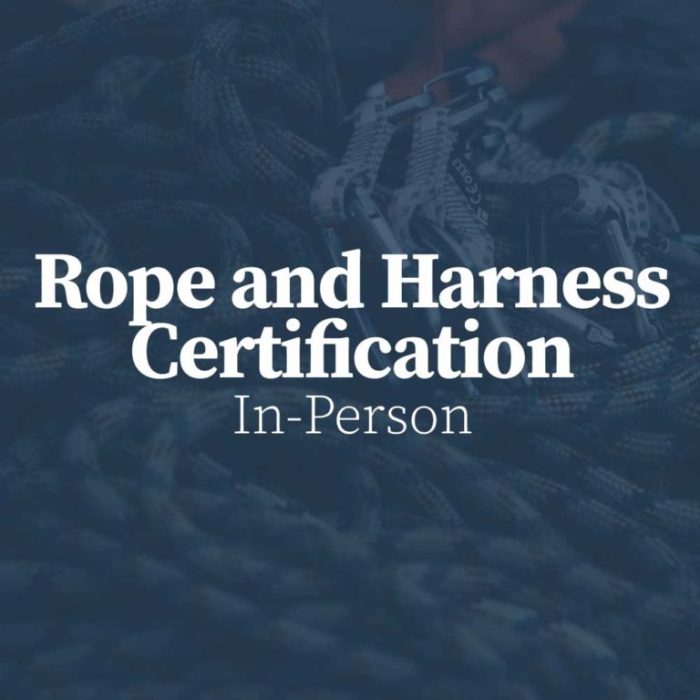Pilot rope and harness certification is a crucial aspect of ensuring safety and compliance in various industries where working at heights is a necessity. This certification provides individuals with the necessary knowledge, skills, and recognition to operate safely and effectively using pilot ropes and harnesses.
This guide will delve into the different types of certifications available, the requirements for obtaining them, and the benefits of becoming certified. We will also explore the process of maintaining certification and selecting an appropriate certification program.
Introduction to Pilot Rope and Harness Certification

Pilot rope and harness certification is a crucial process that ensures the safety of individuals working at heights. It involves assessing the proficiency of personnel in using personal protective equipment (PPE), including pilot ropes and harnesses, to mitigate fall hazards and ensure compliance with safety regulations.
Certification is paramount for several reasons. Firstly, it enhances safety by verifying that workers possess the necessary knowledge, skills, and techniques to use pilot ropes and harnesses effectively. This reduces the risk of falls, injuries, and fatalities.
Importance of Certification
- Enhances safety by verifying worker proficiency in using PPE.
- Reduces the risk of falls, injuries, and fatalities.
- Ensures compliance with safety regulations and industry standards.
- Provides a recognized credential that demonstrates worker competence.
Types of Pilot Rope and Harness Certifications

Certifications for pilot rope and harness usage vary depending on the industry and application. Each certification provides specific training and assessment to ensure individuals possess the necessary knowledge and skills to safely operate and maintain pilot ropes and harnesses.
Industry-Specific Certifications
- Construction Industry: Certifications such as the OSHA 10-Hour Construction Safety and Health Training and the OSHA 30-Hour Construction Safety and Health Training provide general safety knowledge and specific training on fall protection, including pilot rope and harness usage.
- Wind Energy Industry: The Global Wind Organisation (GWO) offers a range of certifications specifically tailored to the wind energy sector, including the GWO Basic Safety Training, GWO Working at Heights, and GWO First Aid Training.
- Telecommunications Industry: Certifications such as the National Institute for Occupational Safety and Health (NIOSH) Telecommunications Certification and the Telecommunications Industry Association (TIA) 101-A Telecommunications Cable Installation Technician provide training and assessment on safe work practices for telecommunications workers, including the use of pilot ropes and harnesses.
Application-Specific Certifications
- Rope Access: Certifications such as the Industrial Rope Access Trade Association (IRATA) Level 1 and Level 2 Rope Access Technician provide specialized training for individuals working in rope access environments, where pilot ropes and harnesses are essential for safety.
- Confined Space Entry: Certifications such as the OSHA Confined Space Entry and the American National Standards Institute (ANSI) Z117.1 Confined Space Entry provide training on the hazards and safety procedures associated with confined space entry, including the use of pilot ropes and harnesses.
- Rescue and Emergency Response: Certifications such as the National Fire Protection Association (NFPA) 1006 Standard for Technical Rescue Operations and the International Association of Fire Fighters (IAFF) Firefighter I and Firefighter II provide training on rescue and emergency response techniques, including the use of pilot ropes and harnesses.
Requirements for Certification

Obtaining certification for pilot rope and harness requires meeting specific requirements. These typically involve training, experience, and testing.Training programs provide candidates with the knowledge and skills necessary to safely and effectively use pilot ropes and harnesses. The programs cover topics such as rope handling, harness inspection and donning, fall protection systems, and rescue techniques.
Candidates must complete a certified training program from an accredited organization to qualify for certification.In addition to training, candidates must have a certain level of experience using pilot ropes and harnesses. This experience can be gained through work or volunteer activities.
Candidates must provide documentation of their experience to the certifying organization.Finally, candidates must pass a certification test to demonstrate their proficiency in using pilot ropes and harnesses. The test typically includes both written and practical components. Candidates must score a passing grade on the test to obtain certification.
Application and Renewal Process
To apply for certification, candidates must submit an application to the certifying organization. The application typically includes information about the candidate’s training, experience, and test scores. Once the application is approved, candidates can take the certification test.Certifications are typically valid for a period of time, such as three or five years.
To renew their certification, candidates must complete a refresher training course and pass a renewal test. The renewal process ensures that certified individuals maintain their knowledge and skills in using pilot ropes and harnesses.
Benefits of Pilot Rope and Harness Certification
Acquiring certification in pilot rope and harness techniques offers numerous advantages for individuals seeking to enhance their safety, career prospects, and professional recognition in the industry.
One of the primary benefits of certification is the increased level of safety it provides. By undergoing a comprehensive training program and demonstrating proficiency in the use of pilot ropes and harnesses, individuals gain the necessary knowledge and skills to work safely at heights and mitigate potential risks.
Job Opportunities
Pilot rope and harness certification opens doors to a wider range of job opportunities in various industries, including construction, wind energy, and telecommunications. Certified individuals are highly sought after by employers due to their specialized skills and proven ability to work safely at heights.
Industry Recognition
Obtaining certification from a reputable organization demonstrates an individual’s commitment to professional development and adherence to industry standards. It serves as a testament to their expertise and competence, enhancing their credibility and marketability within the industry.
Case Studies and Testimonials
- A study conducted by the National Institute for Occupational Safety and Health (NIOSH) found that workers who had undergone pilot rope and harness training experienced a 75% reduction in fall-related injuries.
- A wind turbine technician attributed his certification to saving his life after he fell from a tower and was able to safely descend using the pilot rope and harness system.
Maintaining Certification

Maintaining certification in pilot rope and harness requires ongoing commitment and effort. This includes regular continuing education and proficiency assessments to ensure that certified individuals remain knowledgeable and skilled in the proper use of pilot ropes and harnesses.
Continuing education typically involves attending workshops, seminars, or online courses that cover the latest industry standards, best practices, and safety regulations. Proficiency assessments, on the other hand, are practical evaluations that demonstrate an individual’s ability to safely and effectively use pilot ropes and harnesses in real-world scenarios.
Consequences of Failing to Maintain Certification, Pilot rope and harness certification
Failure to maintain certification can have serious consequences. Certified individuals who fail to complete required continuing education or proficiency assessments may lose their certification. This can impact their employment prospects, as many employers require their employees to maintain valid certifications.
Additionally, individuals who are not properly certified may be held liable for accidents or injuries that occur while using pilot ropes and harnesses.
Choosing a Certification Program: Pilot Rope And Harness Certification
Selecting the most appropriate certification program requires careful consideration of individual needs and career goals. A comprehensive comparison of different programs is essential to make an informed decision.
Various factors to consider include the program’s reputation, curriculum, instructors, and cost. It is also important to ensure that the program meets industry standards and is recognized by potential employers.
Comparison of Certification Programs
| Program | Features | Cost |
|---|---|---|
| Program A | – Comprehensive curriculum
|
$1,000 |
| Program B | – Specialized training
|
$1,200 |
| Program C | – Affordable option
|
$800 |
By comparing these programs, individuals can determine which one best aligns with their specific requirements and financial constraints.
Additional Considerations
In addition to the requirements Artikeld above, there are several other factors to consider when pursuing pilot rope and harness certification.
One important consideration is insurance requirements. Many employers and project owners require their employees or contractors to have pilot rope and harness certification as a condition of employment or participation in certain activities. It is essential to check with your employer or project owner to determine if certification is required and, if so, which certification program they accept.
Another consideration is the need for specialized equipment. In addition to a standard harness and rope, you may need specialized equipment depending on the specific application. For example, if you will be working at heights, you may need a fall arrest system or a self-retracting lifeline.
It is important to consult with a qualified professional to determine what equipment is necessary for your specific needs.
Resources
The following resources can provide further information on pilot rope and harness certification:
- American National Standards Institute (ANSI)
- Occupational Safety and Health Administration (OSHA)
- National Association of Tower Erectors (NATE)
- International Powered Access Federation (IPAF)
FAQ Summary
What are the benefits of obtaining pilot rope and harness certification?
Benefits include increased safety, enhanced job opportunities, and industry recognition.
What are the typical requirements for obtaining certification?
Requirements may include training, experience, and testing.
How can I choose an appropriate certification program?
Consider your needs, career goals, and a comparison of different programs based on features and costs.